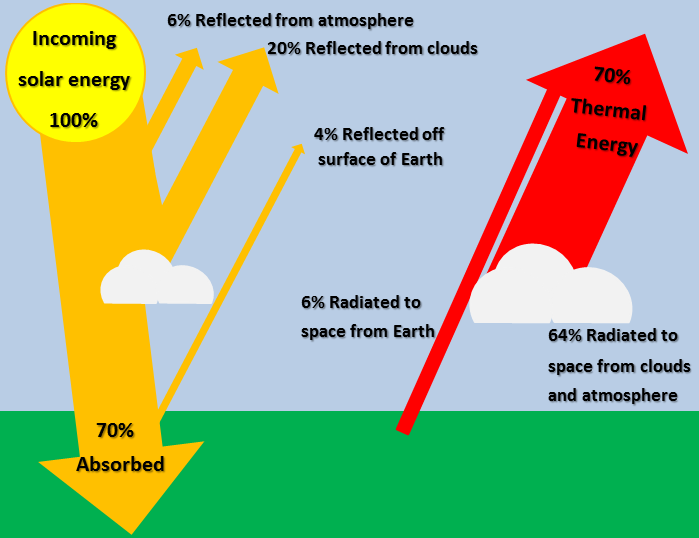Solar energy to the Earth
Almost all of the Earth's energy input comes from the sun. Not all of the sunlight that strikes the top of the atmosphere is converted into energy at the surface of the Earth. The Solar energy to the Earth refers to this energy that hits the surface of the Earth itself. The amount of energy that reaches the the Earth gives a useful understanding of the energy for the Earth as a system. This energy goes towards weather, keeping the temperature of the Earth at a good level for life and powers the entire biosphere. Additionally, this solar energy can be used for solar power either with solar thermal power plants or photovoltaic cells.
Calculating Solar Energy to Surface
Energy from Sun to Earth
The Sun is generally considered to produce a constant amount of power (although there are small variances in the output energy depending on sunspot cycles) with a surface intensity of , expressed in units of power per unit area. As the Sun's rays spread into space this radiation becomes less and less intense as an inverse square law.[1] The average radiation intensity that hits the edge of the Earth's atmosphere is known as the solar constant, or . Although this value is called a constant it varies by about 7% between January 4th (perihelion), when the Earth is closest to the sun, and July 4th (aphelion), when the Earth is furthest away.[2] Therefore a yearly average is used and is determined to be .[1] To determine this value from solar flux, the distance from the Earth to the Sun is used. As well, the total solar flux - not solar flux per unit area - must be determined. Then the total solar flux from the Sun is divided by the surface area of a sphere that has a radius equal to the distance from the Earth to the Sun. This accounts for the "spreading" of the solar energy. The expression to determine this value is:
To determine the approximate amount of solar energy that reaches the surface of the Earth, we must consider what the Earth "looks like" to the Sun. When looking at Earth from the Sun, only one half of the Earth can be seen. Thus to make an appropriate estimate of the amount of solar energy reaching the surface of the Earth from the Sun the value for must be divided by 2. This gives the amount of solar energy reaching the surface of the Earth that is currently facing the Sun, or .[1]
In addition to this, the total solar irradiance is the maximum power delivered to the surface assuming that the path of incoming light is perpendicular to the surface. Due to the fact that the Earth is a sphere, only places near the equator come close to this perpendicular angle. At all other locations on the Earth, incoming light is at some angle. With this decreasing angle, the average solar irradience decreases as well. To account for this, the solar irradiance level is again halved, leaving a final solar irradience of approximately .[3]
Energy to the Surface
Not all of the solar energy that reaches the Earth's atmosphere actually gets to the ground. This is due to something known as the Earth's energy budget.[4] This budget accounts for the fact that some of the energy incident on the outer atmosphere of the planet doesn't actually reach the surface. Due to reflection by the atmosphere and clouds, we can approximate that 70% of solar energy incident on the edge of the Earth's atmosphere actually reaches the surface. Taking this into account, the amount of solar energy reaching the surface amounts to:
We can also determine daily values from this, depending on how long we assume one day is. If we assume one day of sunlight is equal to 12 hours, it is found that the amount of solar energy that reaches the surface of the Earth daily is:[1]
Thus the amount of energy that is incident upon the surface of the Earth from the Sun depends on what month it is and the location that the measurement was taken on the Earth. To put these values into perspective, 1 kWh is equivalent to ten 100 Watt light bulbs being left on for one hour.[5]
Although this amount of energy is quite significant, it does not mean that solar energy can easily provide all of our primary energy. Among the problems that detract include cloudy days and the lack of a reasonable way to store "excess" energy collected on sunny days. As well, this assumes that solar panels are 100% efficient at turning solar energy into electricity or some other usable form of energy, which is not the case. Although solar power is one important type of renewable energy source, it is important to investigate the benefits and drawbacks of this type of energy.[6]
References
- ↑ 1.0 1.1 1.2 1.3 ITACA. (April 4, 2015). The Sun as a Source of Energy [Online]. Available: http://www.itacanet.org/the-sun-as-a-source-of-energy/part-2-solar-energy-reaching-the-earths-surface/
- ↑ For some fun information on perihelion and aperihelion see NASA's page (accessed April 20th, 2015): https://solarsystem.nasa.gov/scitech/display.cfm?ST_ID=2517
- ↑ NASA Earth Observatory. (April 27, 2015). Climate and Earth's Energy Budget [Online]. Available: http://earthobservatory.nasa.gov/Features/EnergyBalance/
- ↑ Oklahoma Climatological Survey. (April 4, 2015). Earth's Energy Budget [Online]. Available: http://okfirst.mesonet.org/train/meteorology/EnergyBudget.html
- ↑ University of Oregon. (April 4, 2015). Solar Energy to the Earth [Online]. Available: http://zebu.uoregon.edu/disted/ph162/l4.html
- ↑ National Geographic. (April 4, 2015). Solar Energy [Online]. Available: http://environment.nationalgeographic.com/environment/global-warming/solar-power-profile/


